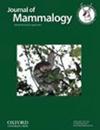在精细空间尺度上雄性美洲斑马狸(Martes americana)栖息地选择模式的季节性变化
IF 1.6
3区 生物学
Q2 ZOOLOGY
引用次数: 0
摘要
古老森林蕴藏着大量复杂的结构特征,形成了多种野生动物栖息地。然而,密集的森林管理正逐渐将古老的森林转化为树龄更年轻、树龄更均匀的林分,从而降低了结构的复杂性,威胁到依赖古老林分的物种的生存。保持复杂的林分结构要素对于保护在其年周期的不同时期使用不同栖息地组成部分的古老森林专家来说至关重要,这需要全面了解这些物种对栖息地需求的季节性变化。然而,由于很难观察到自由活动的动物,我们评估栖息地需求变化的能力有时会受到限制,尤其是对于那些难以捉摸的小型物种。为了解决这个问题,我们使用 GPS 遥测项圈来描述 6 只雄性美国马天貂(Martes americana)在一年中两个不同时期(无雪期,从 4 月中旬到 11 月中旬;积雪期,从 11 月中旬到 4 月中旬)的精细尺度栖息地选择模式,这是以前使用传统甚高频遥测技术难以实现的目标。我们利用第四阶选择的资源选择功能,将马汀鼠使用过的地点(GPS定位点,n = 100)的栖息地特征与每个个体季节性家园范围内同等数量的可用地点(随机点,n = 100)的栖息地特征进行比较。我们对这 200 个地点进行了植被调查,以描述栖息地,并建立了代表不同并发假说的候选模型。我们的研究结果表明,在这两个时期,影响貂栖息地选择的主要因素是猎物的可获得性、捕食者的规避和热限制,尽管它们各自的重要性在不同时期有所不同。在无雪期,貂选择了大直径钉耙密度高(≥30-公顷-1)、针叶林冠层闭合度高(≥53%)和侧向覆盖密(≥81%)的地点,但在积雪期,貂选择了粗木质碎屑量高(≥64 m3-公顷-1)和针叶林冠层闭合度高(≥48%)的地点。我们的研究结果突显了季节变化对比在小型食肉动物栖息地选择模式中的重要性,并可能有助于维持适合雄性美洲马滕犬栖息的景观结构属性。本文章由计算机程序翻译,如有差异,请以英文原文为准。
Seasonal shifts in the habitat selection patterns of male American Marten (Martes americana) at a fine spatial scale
Old-growth forests harbor a large amount of complex structural features that result in a wide array of wildlife habitats. However, intensive forest management is gradually converting old-growth forest into younger, even-aged stands, reducing structural complexity and threatening the persistence of old-growth-dependent species. Maintaining elements of complex stand structure is critical to the conservation of old-growth forest specialists that use different habitat components at different periods of their annual cycle, and it requires a comprehensive understanding of seasonal variation in the habitat needs of these species. However, difficulties in observing free-ranging animals have sometimes limited our ability to assess such variations in habitat requirements, especially for small, elusive species. To address this, we used GPS telemetry collars to describe fine-scale habitat selection patterns of 6 male American Martens (Martes americana) during 2 contrasting periods of the year (snow-free, from mid-April to mid-November; snow-covered, from mid-November to mid-April), an objective formerly hard to achieve using conventional VHF telemetry. We used resource selection functions conducted at the fourth order of selection to compare habitat characteristics found at the sites used by martens (GPS locations, n = 100) to those found on an equal number of available sites (random points, n = 100) within each individual seasonal home range. We conducted vegetation surveys on these 200 sites to describe habitat and built candidate models representing different concurrent hypotheses. Our results showed that proxies of prey availability, predator avoidance, and thermal constraints were the primary factors influencing marten habitat selection during both periods, although their respective importance differed between periods. Martens selected sites with a high density of large-diameter snags (≥30·ha−1), high conifer canopy closure (≥53%), and a dense lateral cover (≥81%) during the snow-free period, but selected sites with a high volume of coarse woody debris (≥64 m3·ha−1) and high conifer canopy closure (≥48%) during the snow-covered period. Our results highlight the importance of contrasting seasonal changes in habitat selection patterns of small carnivores and may help maintain structural attributes in the landscape that are suitable for male American Martens.
求助全文
通过发布文献求助,成功后即可免费获取论文全文。
去求助
来源期刊

Journal of Mammalogy
生物-动物学
CiteScore
3.30
自引率
5.90%
发文量
106
审稿时长
4-8 weeks
期刊介绍:
Papers are published on mammalian behavior, conservation, ecology, genetics, morphology, physiology, and taxonomy.
 求助内容:
求助内容: 应助结果提醒方式:
应助结果提醒方式:


